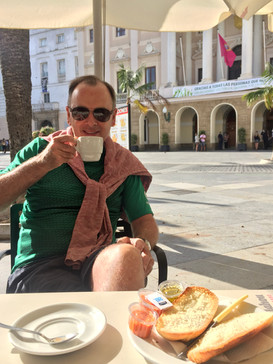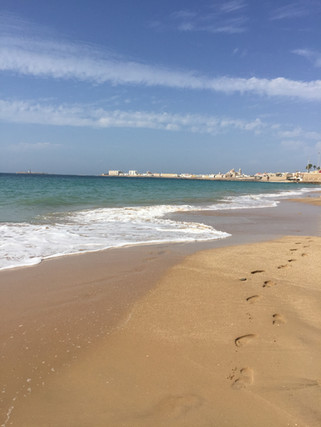Introducing Cádiz
- Fiona
- Dec 11, 2020
- 6 min read
We came to Spain to experience Spanish culture, food, wine, art and architecture; and having lived in many warm countries over the years and liking warmer climates, we headed to the part of this very large country that promised a mild winter.
We initially landed in Seville in February, for Alan to obtain his English teaching qualification – and we fell in love with the city. But, being inland, the Sevilliano summers are intensely hot and the winters chillier than we wanted and so in September, we headed further south to the coast and to Cádiz (pronounced "Cah-deeth") which promised cooler coastal breezes during the hot days and being next to the ocean, milder winter temperatures than Seville. Adding to all this is the historic lure of Cádiz as it has been constantly inhabited for over 3000 years (in fact, it claims that it is the oldest continuously inhabited city in the Western world) and so it promised to be able to sate our appetite for culture, Spanish food and wine, art and architecture…..
A little bit of history...
Cádiz is a small historic port city in the Bay of Cádiz. Thousands of years ago Cádiz, on the southwestern coast of Spain, was part of an archipelago of three islands: Erytheia, Cotinussa and Antipolis. The islands were transformed through geological evolution into what we know today as Cádiz City, Puerto Real and San Fernando.
Cádiz City is is on a sandpit at the end of the peninsula and according to the legend was actually founded 3,000 years ago by Hercules. The seafaring Phoenicians settled here around 1100 B.C. and in 501B.C. the conquering Carthaginians landed. They were followed by the Romans in 206 B.C. Cádiz was conquered by several other invaders, notably the Visigoths and the Muslims. The rule of the Moors came to an end in 1262 when King Alfonso X established Spanish rule. The name of the city has developed over time as well, the Phoenicians called Cádiz Gades and later the Romans called it Gadir.
Also of note is that the port at Cádiz, was where Christopher Columbus set sail for the New World, and in more recent times it has been the port where thousands of cruise ship passengers disembark to explore Spain’s Andalusia region.
First Impressions:
Cádiz has exceeded our expectations...
When we arrived in early September, the day-time temperatures were still in the high twenties which meant that we were happy to join in the outdoor life of the locals. Our most vivid memories are of all the people and dogs (all kinds of dogs, big and small in an interesting assortment of attire) everywhere! On the streets, in the plazas, in the cafes and especially on the beaches.
Street musicians are in abundance here - with lots of flamenco music being played. We are often in our apartment with the balcony doors open listening to the music floating in from the Plaza below.
On most of our early days here, the cloudless skies were a stunning blue intensified by the luminosity of the light that reflected off the stone and whitewashed exteriors of the buildings. It was quite striking! Since then we have also seen cloudy, stormy and foggy skies and they are also quite remarkable. (pictures of the sky further down)
The City and it’s gardens

Cádiz is divided at the old city walls into the ‘old town' and the ‘new town’(as shown in the map above). In the ‘new town’ (which was started in the 1960s) the streets are wide and the buildings are relatively modern. In the ‘Old town’ the streets are narrow and winding and frequently connect up to large plazas that are lined with beautiful old mansion buildings. The ‘old town’ is composed of a number of neighbourhoods called 'barrios’ with interesting histories and wonderful names like El Populo, La Viña and and Santa Maria. The Plazas often have a church and outdoor cafes where we have occasionally had a cafe-con-leche (coffee with milk) or a glass of beer/wine while we enjoyed the sun and watched the people! (more about these plazas in a later post). We particularly love the ‘old town’ and with the exception of our favourite beach, tend to spend most of our time there.
The old part of the city is small and ridiculously easy to walk around; and with the narrow cobbled streets, there are very few vehicles that try to drive along them which makes it great for pedestrians.
Our apartment is marked as ‘home' on the map above and you can see that we are in the middle of the ‘old town’. Some of the windows in our apartment look out over 'Plaza De San Juan de Dios’ (St John of God) this plaza has the Church San Juan de Dios. This Plaza also has the beautiful Ayuntamiento (Town Hall), that was built during the prosperous 18th century (more about this in a later post).
The word is that Cádiz is an authentic Spanish City - there are very few international tourists here - this could be because of its relatively isolated location at the end of the peninsula and also because of the pandemic. Many locals tell us that in the cruise ship season, there can be 2-3 ships docking here each day. We shudder to think of the town inundated by all those people, although we do feel for the owners of the shops, cafes and restaurants that have lost all that business. There are some domestic tourists that come to Cádiz, mainly from Seville and Madrid, but apparently they don’t tend to spend as much as the international tourists.
The most prominent landmark in Cádiz is the Cádiz Cathedral and although it is located next to the sea its towers and characteristic golden dome are visible from numerous spots all around town.
It was built between 1722 and 1838, and is also known as "The Cathedral of The Americas" because it was built with money from the trade between Spain and America. Due to the duration of the build, it is a mixture of architectural styles although mainly baroque and neoclassical, while its golden tiled dome adds a Moorish feel. (more about the Cathedral in a later post)
We have enjoyed several mornings and afternoons sitting in the sun enjoying desayuno (Spanish breakfast) or imbibing either a coffee or a glass of beer or wine at one of the many cafes that are in the plaza that the Cathedral opens onto, while admiring the grandeur of the building, enjoying the music from the street musicians and people watching. Even taking into account this idyllic scene, the best view of the Cathedral has to be from the seafront on the Campo del Sur as it basks in the evening sun.
There are many parks and gardens In both the old and new parts of the city. The older gardens have a number of exotic plants and giant trees, supposedly brought to Spain from the New World by Columbus, as well as statues, fountains and vibrant flowers. My favourite one is the Alameda Apodaca which is part of the walk around the peninsula as noted in the map above.
(hold cursor over each picture for a description)
The ocean...
OMG - We love it! The colours are incredible - the huge variation of blues and greens depending on the colour and density of the clouds. We have paddled in the shallows, but the Atlantic Ocean is a bit cold for me to swim (I was spoilt swimming in the warm waters of Samoa and South-east Asia!!). The beaches are sandy and lovely to walk along - which we do often - the fresh salty air, the mesmerising sound and movement of the waves, the sun on our backs - mmm - very therapeutic!
And when we get a bit hot there is usually a bar not too far away where we can quench our thirst with an ice-cold beer while still enjoying stunning sea views!
Sunsets
And as for the sunsets - they are dazzling, every one is different and you can never see enough of them!
Our favourite place to watch the sunset is along the sea wall at the end of the old city but we also like the view from our roof terrace where many of the beautiful buildings (including the Cadiz Cathedral) become fabulous silhouettes.
Take a look at the following pictures and see for yourself...



















































































































Commentaires